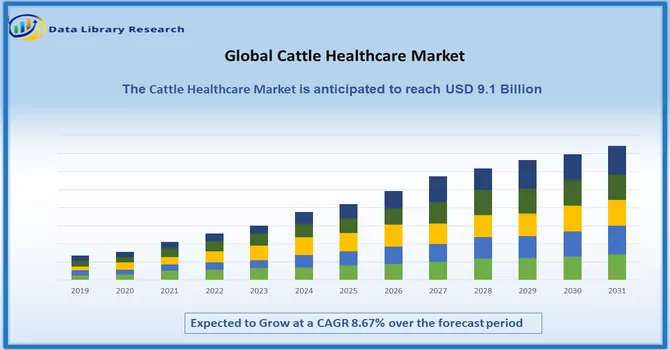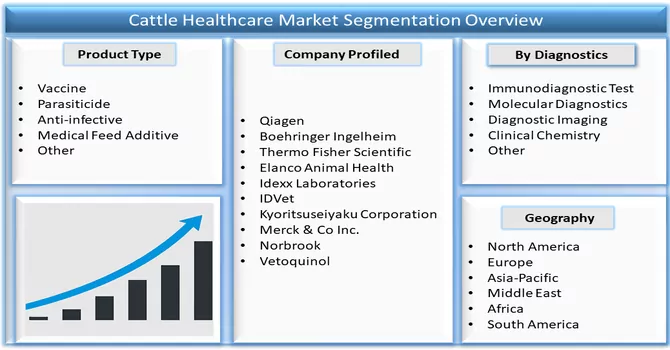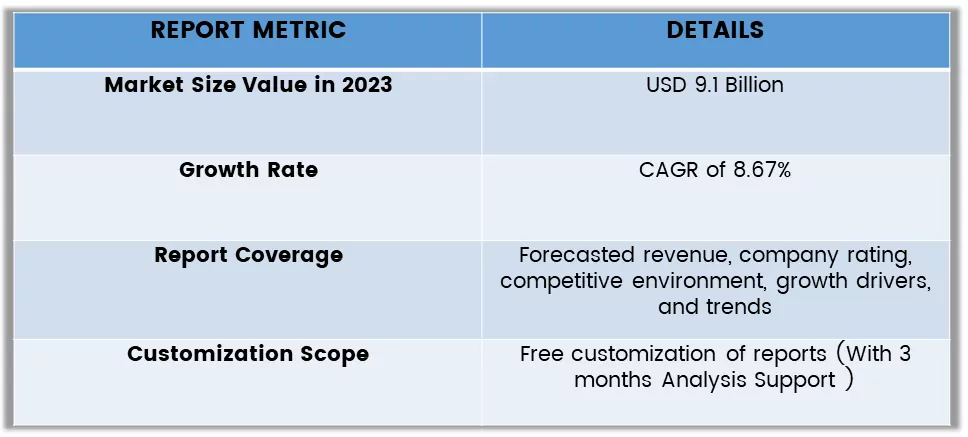The Cattle Health Market size is estimated at USD 9.1 billion in 2023 and is expected to have a CAGR of 8.67% during the forecast period, 2024-2031.

Get Complete Analysis Of The Report- Download Free Sample PDF
In the landscape of the Cattle Healthcare market, the focus is on ensuring the well-being and health of cattle, playing a crucial role in livestock management. The market encompasses a spectrum of products and services tailored to address the healthcare needs of cattle, including preventive measures, diagnostics, treatments, and nutritional supplements. As the global demand for high-quality dairy and meat products rises, there is a growing emphasis on maintaining optimal health conditions for cattle through the adoption of advanced healthcare solutions.
Factors such as disease prevention, vaccination programs, and innovative veterinary interventions contribute to the overall growth and sustainability of the Cattle Healthcare market, aligning with the welfare and productivity goals of the livestock industry. The growth of the Cattle Healthcare market is propelled by several key factors, with a primary driver being the increasing global demand for high-quality dairy and meat products. As the population continues to rise, there is a parallel surge in the need for sustainable and efficient livestock management practices. Farmers and cattle ranchers are recognizing the importance of maintaining the health and well-being of their herds to meet these demands. This has led to a rising focus on preventive healthcare measures, advanced diagnostics, and innovative treatments to enhance the overall health and productivity of cattle. Additionally, regulatory initiatives promoting animal welfare and the adoption of modern veterinary practices contribute significantly to the expansion of the Cattle Healthcare market.
Market Segmentation: Cattle Health Market and it is Segmented by Product Type (By Therapeutics (Vaccine, Parasiticide, Anti-infective, Medical Feed Additive, and Other Therapeutics) and By Diagnostics (Immunodiagnostic Test, Molecular Diagnostics, Diagnostic Imaging, Clinical Chemistry, and Other Diagnostics), and Geography (North America, Europe, Asia-Pacific, Middle East and Africa, and South America). The market provides the value (in USD million) for the above-mentioned segments.

For Detailed Market Segmentation - Download Free Sample PDF
The Cattle Healthcare market is witnessing notable trends driven by a shift towards precision livestock farming and technology integration. There is a growing adoption of digital tools, including wearable devices and smart monitoring systems, to track and manage cattle health remotely. Precision diagnostics, such as genomic testing for disease resistance and susceptibility, are becoming increasingly prevalent. Additionally, there is a rising emphasis on sustainable and natural healthcare solutions, leading to the exploration of alternatives like herbal supplements and organic remedies. Furthermore, the integration of data analytics and artificial intelligence in cattle healthcare management is emerging as a trend, providing valuable insights for proactive health management and disease prevention strategies. These trends collectively signify a modernization and transformation in the approach towards cattle healthcare practices.
Market Drivers:
Increasing Global Demand for High-Quality Dairy and Meat Products
The rising global population and growing affluence have led to an increased demand for high-quality dairy and meat products. This surge in demand puts pressure on livestock producers to maintain the health and productivity of their cattle herds. Cattle healthcare solutions play a pivotal role in ensuring the overall well-being of animals, preventing diseases, and optimizing production for a consistent supply of quality products.
Technological Advancements in Veterinary Medicine
The continuous advancements in veterinary medicine and technology contribute significantly to the growth of the Cattle Healthcare market. Innovations such as precision diagnostics, wearable sensors, real-time monitoring systems, and telehealth applications empower farmers and veterinarians to monitor the health parameters of cattle more effectively. These technologies not only aid in early disease detection but also assist in implementing preventive measures, improving overall herd management efficiency.
Market Restraints:
The implementation of advanced healthcare practices and technologies in cattle farming often involves substantial costs. Small-scale and resource-constrained farmers may find it challenging to afford high-tech veterinary solutions, diagnostics, and medications. Additionally, ongoing operational expenses related to healthcare management can pose financial burdens. These cost constraints may limit the widespread adoption of sophisticated cattle healthcare practices, particularly among smaller agricultural enterprises, hindering the overall growth of the market. Addressing these affordability issues is crucial to ensuring inclusive access to effective healthcare solutions for cattle across diverse farming operations.
The COVID-19 pandemic has significantly impacted the Cattle Healthcare market, introducing both challenges and opportunities. On one hand, disruptions in the supply chain and restrictions on movement have led to logistical challenges, affecting the timely availability of veterinary products and services. The pandemic-induced economic uncertainties have also influenced farmers' spending patterns, potentially impacting their investment in cattle healthcare.On the other hand, the crisis has underscored the importance of resilient and sustainable food supply chains, prompting increased awareness regarding the health and well-being of livestock. This heightened awareness has accelerated the adoption of digital health solutions, telemedicine, and precision agriculture in cattle farming. The emphasis on biosecurity measures to prevent the spread of diseases has gained prominence, driving the demand for vaccines, diagnostics, and other healthcare products. Furthermore, governments and regulatory bodies have recognized the vital role of the agriculture sector during the pandemic, leading to supportive policies and initiatives. As the world adapts to the post-pandemic landscape, the Cattle Healthcare market is poised to witness a shift towards more technology-driven, efficient, and sustainable healthcare practices in the livestock industry.
Segmental Analysis:
Vaccine Segment is Expected to Witness Significant Growth Over the Forecast Period
Vaccines play a crucial role in cattle healthcare, helping to prevent and control a variety of diseases that can impact cattle health and productivity. Vaccines are used to protect cattle from diseases such as bovine respiratory disease (BRD), clostridial diseases, and bovine viral diarrhoea (BVD), among others. Vaccination programs are designed to target specific diseases based on factors such as the age and health status of the cattle, as well as the prevalent diseases in the region.In addition to preventing disease, vaccines can also improve overall herd health and productivity. By reducing the incidence of disease, vaccines can help reduce the need for antibiotic treatments and other costly interventions. This can lead to healthier cattle, increased production efficiency, and ultimately, higher profitability for cattle producers. Thus, vaccines are an essential tool in cattle healthcare, playing a vital role in disease prevention, herd health management, and sustainable cattle production. As the demand for high-quality beef and dairy products continues to grow, the importance of vaccines in maintaining cattle health and productivity is expected to increase.
North America Region is Expected to Witness Significant Growth Over the Forecast Period
In North America, cattle healthcare is a critical component of the livestock industry, which plays a significant role in the region's economy. Cattle are raised for beef and dairy production, making their health and well-being a top priority for producers. Cattle healthcare in North America involves various practices, including vaccination, disease prevention, and treatment. Vaccination programs are commonly used to protect cattle from diseases such as bovine respiratory disease (BRD), clostridial diseases, and bovine viral diarrhea (BVD). These programs are tailored to the specific needs of each herd, taking into account factors such as the age, breed, and health status of the cattle. In addition to vaccination, cattle healthcare in North America also involves regular health monitoring, nutrition management, and disease management practices. Producers work closely with veterinarians to ensure that their cattle receive the care they need to stay healthy and productive. Thus, cattle healthcare is a priority in North America, with producers implementing various measures to ensure the health and well-being of their herds. As the demand for high-quality beef and dairy products continues to grow, the importance of cattle healthcare in North America is expected to remain high.

Get Complete Analysis Of The Report - Download Free Sample PDF
The analyzed market exhibits a high degree of fragmentation, primarily attributable to the presence of numerous players operating on both a global and regional scale. The competitive landscape is characterized by a diverse array of companies, each contributing to the overall market dynamics. This fragmentation arises from the existence of specialized solution providers, established industry players, and emerging entrants, all vying for market share. The diversity in market participants is underscored by the adoption of various strategies aimed at expanding the company presence. On a global scale, companies within the studied market are strategically positioning themselves through aggressive expansion initiatives. This often involves entering new geographical regions, targeting untapped markets, and establishing a robust global footprint. The pursuit of global expansion is driven by the recognition of diverse market opportunities and the desire to capitalize on emerging trends and demands across different regions. Simultaneously, at the regional level, companies are tailoring their approaches to align with local market dynamics. Regional players are leveraging their understanding of specific market nuances, regulatory environments, and consumer preferences to gain a competitive edge. This regional focus allows companies to cater to the unique needs of local clientele, fostering stronger market penetration. To navigate the complexities of the fragmented market, companies are implementing a range of strategies. These strategies include investments in research and development to stay at the forefront of technological advancements, mergers and acquisitions to consolidate market share, strategic partnerships for synergies, and innovation to differentiate products and services. The adoption of such multifaceted strategies reflects the competitive nature of the market, with participants continually seeking avenues for growth and sustainability. In essence, the high fragmentation in the studied market not only signifies the diversity of players but also underscores the dynamism and competitiveness that drive ongoing strategic maneuvers. As companies explore various avenues for expansion, the market continues to evolve, presenting both challenges and opportunities for industry stakeholders.
Some of the key market players working in this segment are:
Recent Development:
1) In June 2022, Petco Health and Wellness Company Inc. initiated a novel community-focused testing concept aimed at addressing the health and wellness requirements of pets and farm animals residing in smaller towns and rural areas. This innovative approach seeks to extend healthcare services to areas with limited access to such resources, fostering the well-being of animals in traditionally underserved communities.
2) In April 2022, two prominent synthetic biology firms based in the United States, Ginkgo Bioworks and Elanco, collaborated to establish BiomEdit. This newly formed microbiome innovation company is dedicated to the development of cutting-edge animal health products and services. The collaboration leverages synthetic biology techniques to advance microbiome-related solutions, showcasing a commitment to pushing the boundaries of innovation in the field of animal healthcare.
Q1. What was the Cattle Healthcare Market size in 2023?
As per Data Library Research the Cattle Health Market size is estimated at USD 9.1 billion in 2023.
Q2. At what CAGR is the Cattle Healthcare market projected to grow within the forecast period?
Cattle Healthcare Market is expected to have a CAGR of 8.67% during the forecast period.
Q3. What are the factors on which the Cattle Healthcare market research is based on?
By Product Type, By Dignostics And Geography are the factors on which the Cattle Healthcare market research is based.
Q4. What are the factors driving the Cattle Healthcare market?
Key factors that are driving the growth include the Increasing Global Demand for High-Quality Dairy and Meat Products and Technological Advancements in Veterinary Medicine.
Data Library Research are conducted by industry experts who offer insight on industry structure, market segmentations technology assessment and competitive landscape (CL), and penetration, as well as on emerging trends. Their analysis is based on primary interviews (~ 80%) and secondary research (~ 20%) as well as years of professional expertise in their respective industries. Adding to this, by analysing historical trends and current market positions, our analysts predict where the market will be headed for the next five years. Furthermore, the varying trends of segment & categories geographically presented are also studied and the estimated based on the primary & secondary research.
In this particular report from the supply side Data Library Research has conducted primary surveys (interviews) with the key level executives (VP, CEO’s, Marketing Director, Business Development Manager and SOFT) of the companies that active & prominent as well as the midsized organization
FIGURE 1: DLR RESEARH PROCESS

Extensive primary research was conducted to gain a deeper insight of the market and industry performance. The analysis is based on both primary and secondary research as well as years of professional expertise in the respective industries.
In addition to analysing current and historical trends, our analysts predict where the market is headed over the next five years.
It varies by segment for these categories geographically presented in the list of market tables. Speaking about this particular report we have conducted primary surveys (interviews) with the key level executives (VP, CEO’s, Marketing Director, Business Development Manager and many more) of the major players active in the market.
Secondary ResearchSecondary research was mainly used to collect and identify information useful for the extensive, technical, market-oriented, and Friend’s study of the Global Extra Neutral Alcohol. It was also used to obtain key information about major players, market classification and segmentation according to the industry trends, geographical markets, and developments related to the market and technology perspectives. For this study, analysts have gathered information from various credible sources, such as annual reports, sec filings, journals, white papers, SOFT presentations, and company web sites.
Market Size EstimationBoth, top-down and bottom-up approaches were used to estimate and validate the size of the Global market and to estimate the size of various other dependent submarkets in the overall Extra Neutral Alcohol. The key players in the market were identified through secondary research and their market contributions in the respective geographies were determined through primary and secondary research.
Forecast Model
